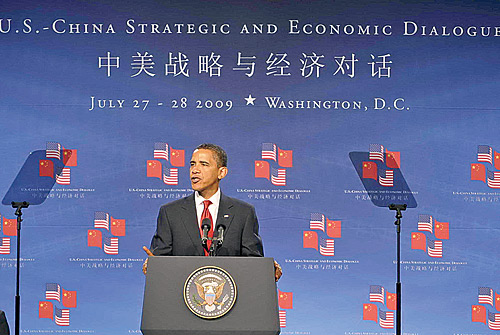|
 |
|
GRAND OPENING: U.S. President Barack Obama addresses the China-U.S. Strategic and Economic Dialogue in Washington, D.C. on July 27 (XINHUA) |
The China-U.S. relationship for the 21st Century is being forged in a new, strategically interdependent world—a globalized world no longer characterized by the zero-sum strategic competition among the major powers that dominated the Cold War and preceding eras. The United States and China are not strategic competitors but rather face common strategic challenges that can be met only through cooperation of the international community, especially China and the United States. This strategic interdependence is likely to deepen in coming decades in the face of growing economic interconnectedness, increasing threats of environmental degradation affecting the entire planet, especially climate change, global pandemics and resource depletion as well as on-going threats to global instability resulting from terrorism and proliferation of weapons of mass destruction.
 |
|
(COURTESY OF BANNING GARRETT) |
The new strategically interdependent world has created a win-win, lose-lose relationship between China and the United States. Whether they prefer to or not, the United States and China each has a vital national interest in the success of the other power, especially its economic success, and would be threatened by its failure. The current financial and economic crisis has dramatically demonstrated this strategic interdependence. The existential threat of climate change provides even more dramatic proof that we are in the proverbial "same boat" on a wide range of global challenges.
China and the United States need to move toward a new stage in their relationship beyond acting as "responsible stakeholders" in their unilateral policies to enhancing U.S.-China coordination and collaboration in designing and implementing policy responses to shared strategic challenges and threats. The goal of this U.S.-China strategic partnership should be to marshal the combined power of the United States and China to address urgent and long-term strategic challenges, including managing the global economy and building a sustainable, new financial and economic order; tackling climate change and effecting a global transition to low-carbon sustainable economic development; strengthening global governance and regional institutions; and addressing the wide range of threats to global security posed by terrorism, proliferation, climate change impacts and pandemics, among others.
Such U.S.-China collaboration would also mark a shift from a "balance of power" strategy aimed at maximizing national standing vis-à-vis other countries to a strategy of "pooling of power" with other nations to address common problems to enhance international security and prosperity. Pooling of power already can be seen in the deployment of Chinese warships to work with the naval forces of the United States, NATO and other countries to counter piracy against commercial shipping off the Horn of Africa.
Besides pooling of power, China and the United States need to pursue "catalytic power" to spur the global community to respond effectively to the 21st century strategic challenges. This catalytic power would be demonstrated by China and the United States cooperating effectively on climate change and clean energy to enhance prospects in the near term for an agreement at Copenhagen on reductions of greenhouse gas emissions and in the long run to accelerate a global trend toward large-scale deployment of clean energy systems and sustainable, low-carbon economic development on a global scale.
| 